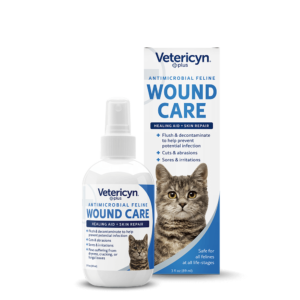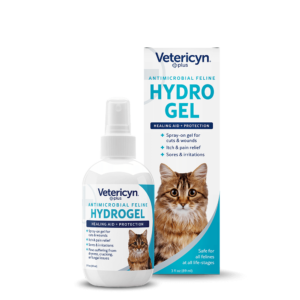Updated May 14, 2025
As a cat owner, you know your cat’s favorite scratch zones—under the chin, the base of the tail, and behind those adorable ears. If you notice skin irritation, scabs, or sores on your cat’s ears during your scratch sessions, it may be a sign of an underlying feline skin condition.
Often, feline skin issues can be managed at home. In this article, we’ll discuss the possible causes of cat ear scabs, and share safe and effective home care tips.
The Clue: Millet Seed-size Bumps
Cat skin reacts to irritants in only a few characteristic ways, called reaction patterns. One of those reaction patterns is miliary dermatitis. That’s a fancy way of saying there are many small, hard bumps that typically show up on the back, neck, and face, including the ears. The bumps are about the size of a millet seed, hence the name ‘miliary’ dermatitis.1
Veterinarians often see cats for miliary dermatitis. In fact, it’s one of the most common skin problems in cats.1
The Scab Culprits
Miliary dermatitis is one way cats’ skin reacts to triggers. The things that cause the reaction include fleas, other insects, food allergies, infections, nutritional problems, and sometimes systemic diseases.1
Flea saliva is a frequent culprit. Once it’s deposited into the cat’s skin, the saliva triggers severe itchiness in allergic cats. They’ll scratch and scratch, creating sores and scabs. It’s a systemic problem. The cat’s entire body will react to the flea saliva, so bumps can occur even in spots with no actual flea bite. Usually, the ears, face, neck, and back are affected.2
Other miliary dermatitis culprits include:
- Ear Mites – These are microscopic parasites of the skin that cause mange. They infect the ears but also cause redness, hair loss, itching, and general irritation of the skin of the ears.3
- Allergies to food, dust, or other environmental allergens – Allergies can develop at any time during your cat’s life, causing symptoms of cat skin allergies. Check for any recent changes in your cat’s environment that could be causing dermatitis, and talk to your veterinarian about switching your cat to hypoallergenic food.3
- Medications – Ear medications can irritate the ear and nearby skin, so let your veterinarian know if you notice skin problems after starting a new therapy.3
- Infection – A bacterial skin infection might also occur.1 Other symptoms, including lethargy or decreased appetite, could occur if this is the case. Excessive head shaking and a foul-smelling discharge from the ear can also indicate a cat ear infection, often accompanied by inflammation.
A vet can usually determine the cause of feline miliary dermatitis through a combination of tests, a thorough examination, and your cat’s medical history.
Identifying Different Types of Cat Ear Scabs
Not all scabs are the same. The appearance of the scabs on your cat’s ears can give you clues about what’s going on under the surface. While the underlying cause will need to be diagnosed by your vet, here are a few common types of cat scabs you might notice:
- Crusty or dry scabs – These are the most common type and often linked to flea allergies or miliary dermatitis. They usually feel gritty or flaky to the touch, like a scab you’d find after a small scratch.
- Moist or oozing scabs – If the area looks wet or sticky, your cat might have a bacterial or fungal infection. These scabs are often paired with redness, swelling, or a foul smell.
- Thick or bloody scabs – These may result from intense scratching, often caused by ear mites, foreign bodies, or extreme itchiness from allergies. If your cat’s ears are bleeding or the scabs seem deep, it’s time to check in with your vet.
Whatever the type, scabs are your cat’s way of telling you something’s wrong. By paying attention to how they look and what other symptoms are showing up, so you can help your feline friend get the relief they need, faster.
Treatment for Scabs on Cat’s Ears
If your cat has scabs on their ears, it’s important to treat both the symptoms and the root cause. Scabs are often a sign of an underlying issue like parasites, allergies, or infection—so effective treatment starts with identifying what’s triggering the skin reaction. From there, you can take targeted steps to relieve discomfort and support healing.
Step 1: Identify and Eliminate the Underlying Cause
Before treating the scabs themselves, you need to find and address the root cause of your cat’s skin irritation. Common culprits include1,3:
- Fleas and mites — Start with a full flea and mite treatment protocol, even if you don’t see pests. Use vet-recommended flea prevention and treat all pets in the household, as well as bedding and living spaces. Otherwise, the fleas can repopulate the pet, causing a continuous flea allergy cycle.
- Food allergies or environmental triggers — Work with your vet to implement an elimination diet or allergy testing to determine if your cat reacts to certain ingredients or environmental allergens (e.g., pollen, dust mites). Remove allergens from their environment or change their diet.
- Bacterial or fungal infections — These may require specific treatment, like antibiotics or antifungal medications.

Step 2: Soothe and Support the Healing of Scabs
Removing the underlying problem starts healing your cat’s miliary dermatitis. But you can promote healing with these additional options:
-
- Antihistamines – If you’ve dealt with allergies, you’re probably familiar with using antihistamines to stop sneezing, sniffling, and itching. An antihistamine can help cats too, but they don’t start working until after a few days, and they may cause unwelcome side effects. Follow your veterinarian’s advice if you use an antihistamine for your cat.1
- Steroid – Steroids can help relieve itching. But steroids may cause other problems, so it’s best only to use a steroid as directed by your veterinarian. Your veterinarian may give your cat a steroid injection or send you home with steroid pills.4
- Antibiotics – In cases of bacterial infection, your vet may prescribe antibiotics.4
- Topical Treatments – Vetericyn Plus® Feline Antimicrobial Facial Therapy doesn’t have antibiotics, steroids, or alcohol, so it won’t sting or burn. Use it multiple times daily to safely aid healing of sores, scabs, and itchy spots around the face, eyes, nose, mouth, ears, and chin.
- E-Collar – An Elizabethan collar, otherwise known as an e-collar, is the best way to stop your cat from causing more skin damage. With the cone around their neck, your cat can’t scratch the scabs on their face and ears. Although your cat may find the cone annoying at first, they’ll quickly adjust and be well on their way to healthy, scab-free skin.
How to Prevent Future Flare-Ups
Once your cat’s skin is healed, preventing flare-ups is key. Try these tips:
- Routine parasite control — Keep your cat on a consistent flea prevention schedule year-round, even indoors.
- Regular ear checks — Clean and inspect your cat’s ears weekly for early signs of irritation or debris.
- Food trials — If food allergies are suspected, work with your vet to run an elimination diet and identify triggers.
- Stress reduction — Cats can overgroom or scratch more when stressed. Maintain a calm environment and provide enrichment.
Prevention is easier and kinder to your cat than repeated treatment cycles.

Vetericyn: Caring for Animals with Safe, Non-toxic Pet Wellness Products
Our cat care products are manufactured in the US and trusted by veterinarians worldwide for treating skin problems and other issues in many species. Visit our blog to learn more about managing cat wounds and to check all our pet wellness products.
From our Vetericyn Plus® Antimicrobial Ear Rinse to antimicrobial wound and skin care, to plant-based medicated shampoo that leaves your cat’s fur soft and clean, we’re committed to providing products you and your animal companions will love.
 Reviewed by Dr. Kathy Adamson
Reviewed by Dr. Kathy Adamson
Dr. Kathy Adamson earned her bachelor’s degree from the University of Notre Dame and her Doctor of Veterinary Medicine degree from the University of Wisconsin-Madison School of Veterinary Medicine.
She completed a one-year small animal medicine and surgery internship at the North Carolina State College of Veterinary Medicine. Alongside her studies, Kathy worked in a research lab, contributing as an author and co-author to various journal articles.
She has also pursued medical writing and editing certification through the University of Chicago Graham School. Currently, she runs KMA Veterinary & Medical Writing, a freelance medical writing company, serves as the Digital Content Manager for the Greater Chicago Area Chapter of the American Medical Writers Association, is a member of the AMWA Communications Committee, and enjoys writing about healthcare topics for people and their cherished pets.
![]() https://www.linkedin.com/in/kathyadamsondvm/
https://www.linkedin.com/in/kathyadamsondvm/
Sources:
- Bettenay S. Feline Cutaneous Reaction Patterns–Practical Hints and Tips. Veterinary Information Network. Accessed February 18, 2025. https://www.vin.com/members/cms/project/defaultadv1.aspx?pid=11268&catId=&id=3866615&said=&meta=&authorid=&preview=
- Dryden M. Fleas of Cats. Merck Veterinary Manual. Updated 2024. Accessed February 18, 2025. https://www.merckvetmanual.com/cat-owners/skin-disorders-of-cats/fleas-of-cats?query=fleas%20of%20cats
- Torres M. Disorders of the Outer Ear in Cats Merck Veterinary Manual. Updated 2024. Accessed February 18, 2025. https://www.merckvetmanual.com/cat-owners/ear-disorders-of-cats/disorders-of-the-outer-ear-in-cats?query=Disorders%20of%20the%20Outer%20ear%20in%20cats
- Dryden M. Flea Allergy Dermatitis in Dogs and Cats Merck Veterinary Manual. Updated 2024. Accessed February 18, 2025. https://www.merckvetmanual.com/integumentary-system/fleas-and-flea-allergy-dermatitis/flea-allergy-dermatitis-in-dogs-and-cats?query=flea%20allergic%20dermatitis%20in%20dogs%20and%20cats


